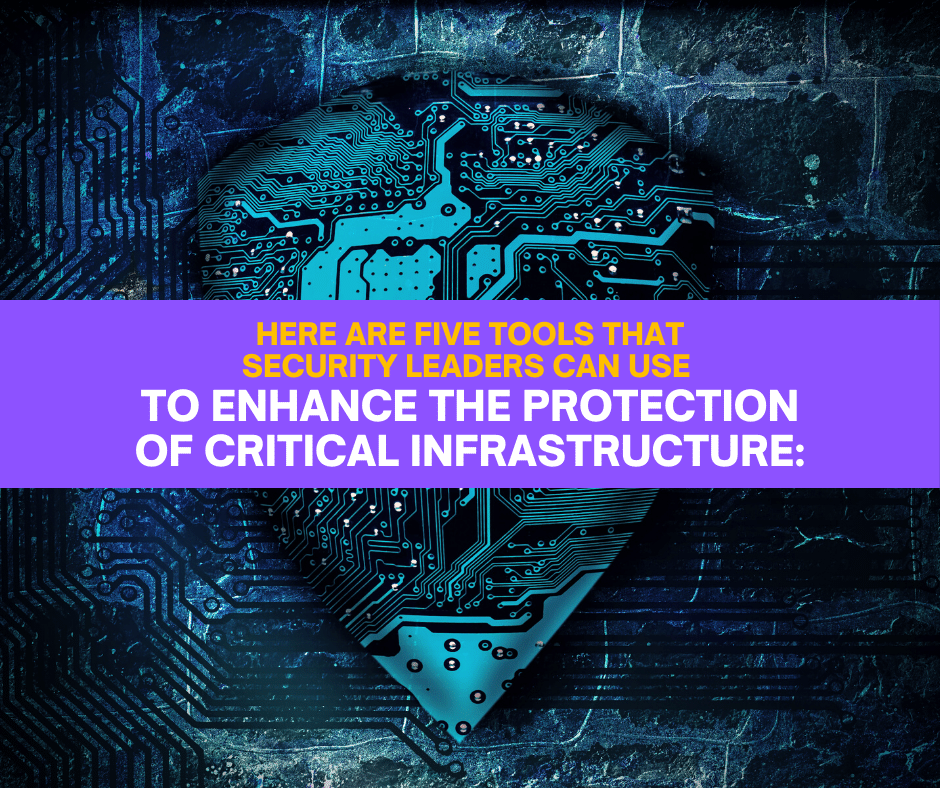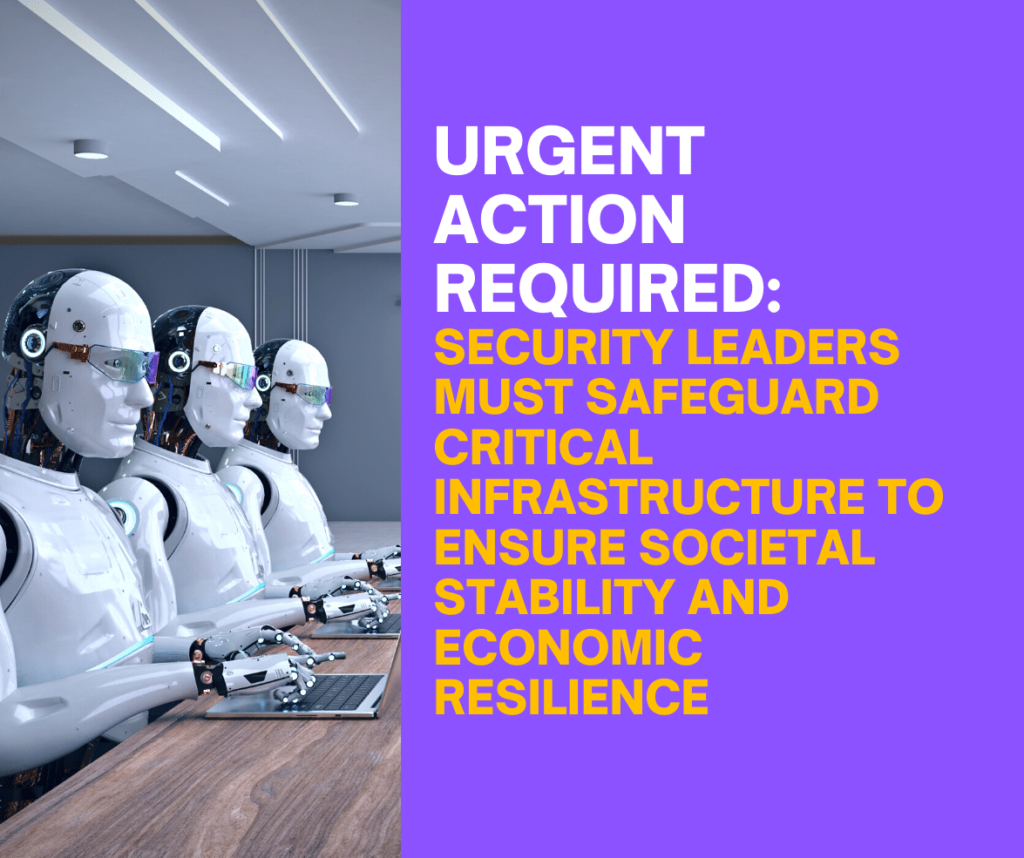Security leaders must take immediate action to safeguard critical infrastructure, as these systems are essential for a society to function correctly. Critical infrastructure refers to vital sectors like energy, water, transportation, communication, and healthcare. Any disruptions or attacks on these systems can result in severe consequences such as economic losses, risks to public safety, and social disruption.
Here are five tools that security leaders can use to enhance the protection of critical infrastructure:

Risk Assessment and Management:
Conducting comprehensive risk assessments is essential to identify vulnerabilities and potential threats to critical infrastructure. Security leaders can use various frameworks and methodologies to assess risks, prioritize them based on impact and likelihood, and develop mitigation strategies accordingly. Regular risk assessments help understand the evolving threat landscape and adapt security measures accordingly.
Security Monitoring and Incident Response:
Implementing robust security monitoring systems allow security leaders to promptly detect and respond to potential security incidents. Intrusion detection systems, security information and event management (SIEM) solutions, and real-time threat intelligence can help identify and mitigate attacks on critical infrastructure. An efficient incident response plan ensures quick containment, investigation, and recovery from security breaches.
Access Control and Authentication:
Strong access control mechanisms are vital for protecting critical infrastructure. Multi-factor authentication, privileged access management, and strict user access policies help prevent unauthorized access to critical systems. By limiting access to authorized personnel and implementing robust authentication protocols, security leaders can reduce the risk of insider threats and external breaches.
Encryption and Data Protection:
Encryption is a crucial tool to secure sensitive data in transit and at rest. Security leaders should implement encryption measures to protect critical information, including customer data, system configurations, and operational details. Data loss prevention (DLP) solutions can help identify and prevent unauthorized data transfers, ensuring the confidentiality and integrity of critical information.
Continuous Security Training and Awareness:
Human error and social engineering attacks are common security risks. Security leaders should prioritize ongoing training and awareness programs for employees and stakeholders in the critical infrastructure sector. By promoting a security-conscious culture, individuals can better understand potential threats, recognize phishing attempts, and follow best practices to safeguard essential systems.
Combined with a holistic and proactive security strategy, these tools can significantly enhance critical infrastructure protection. Security leaders must stay updated on emerging threats, collaborate with industry peers, and adhere to relevant security standards and regulations to ensure the resilience of critical infrastructure in the face of evolving security challenges.
Let’s cite a recent case where critical infrastructure, the daily operations of the United States dependent on functional processes. The Colonial Pipeline, a vital artery for distributing refined oil products across the United States, stretches an impressive 5,500 miles from Texas to New York, transporting 3 million barrels of fuel daily. However, its significance was highlighted on May 6, 2021, when a cyber-attack, the most significant publicly disclosed on critical U.S. infrastructure, by a group known as DarkSide, disrupted its operations.
In a case study conducted by the Cyberspace Solarium Commission (2022), it was revealed that many respondents believed the physical infrastructure of the pipeline was compromised during this attack. However, DarkSide’s operations were much more insidious. The group managed to exfiltrate approximately 100 gigabytes of data within two hours, directly impacting the pipeline’s billing and accounting systems. Surprisingly, the physical infrastructure was left untouched.
Upon discovering the intrusion and subsequent ransom demand of $4 million in Bitcoin, a consortium of national security agencies, including the FBI, U.S. Department of Energy, Department of Homeland Security, and CISA (Cybersecurity and Infrastructure Security Agency), were alerted. Despite the enormous risk and controversy surrounding such a decision, the company’s CEO and Board of Directors opted to pay the ransom. Remarkably, $2.4 million, equivalent to 64 out of 75 bitcoins, was later retrieved. Within five days, the pipeline’s operations were restored.
The breach was made possible through a VPN attack initiated by the hackers, who capitalized on a sensitive, reused password, according to TechTarget’s Sean Michael Kerner (April 26, 2022). The password may have been compromised in a different data breach. As a response, leaders in security and business must stress the importance of utilizing unique passwords across other platforms and enforce this as a policy.
The Colonial attack led to widespread fear of a fuel shortage, triggering panic buying and long lines at gas stations in several states, including Florida, Georgia, Alabama, Virginia, and the Carolinas. A sharp increase in gasoline prices was also observed, reflecting the fragility of the supply chain.
In recent months, similar cyber breaches have been acknowledged by institutions such as Georgia State University and Johns Hopkins University. Sensitive personal, financial, and even health billing records were suspected of having been stolen, as reported by CNN’s Sean Lyngaas.
The significance of robust cybersecurity measures cannot be overstated. For instance, consider the case of Tesla, Kriuchkov, with conspiracy to cause damage to a protected computer intentionally.
According to the allegations, Kriuchkov traveled to the United States to recruit and bribe an insider within the Tesla company. The plan was to install malware into Tesla’s internal computer system. The intended malware attack was a form of ransomware, with the end goal of extracting sensitive company data and demanding a significant payment to prevent the data from being leaked to the public.
However, the employee Kriuchkov attempted to recruit reported the matter to Tesla, who alerted the FBI. A sting operation was set up, leading to Kriuchkov’s arrest. This case highlights the significant threat posed by insider attacks and the importance of vigilance and the proper reporting of suspicious activities by employees.
Like other Black Hat Cyberhackers, DarkSide is a cybercriminal group known for deploying ransomware attacks. Darkside surfaced in mid-2020 and has been linked to several high-profile cyberattacks, the most notorious being the attack on the Colonial Pipeline in the United States in May 2021.
The group operates on a “Ransomware-as-a-Service” (RaaS) model. This means that the core members of DarkSide develop and maintain the ransomware software and payment infrastructure. At the same time, “affiliates” are responsible for breaching the network of victims and deploying the ransomware. Profits are then shared between the core members and the affiliates.
One distinct characteristic of DarkSide is its so-called “Robin Hood” image. The group has been known to donate some of its ransom proceeds to charities, although many have refused to accept such donations.
DarkSide’s ransomware attacks are highly targeted and are often aimed at large corporations. They do substantial research on their targets and set the ransom amount based on the target’s estimated capacity to pay. They also threaten to release sensitive stolen data publicly if the ransom is not paid, a tactic known as “double extortion.”
The group allegedly disbanded shortly after the Colonial Pipeline attack due to increased scrutiny from law enforcement and international media. Still, the group’s and its members’ actual status has yet to be definitively discovered. Some cybersecurity experts suspect that the group could have rebranded and continues to operate under a different name.
Leaders must immediately implement the earlier measures to harden infrastructure, particularly for critical sectors like nuclear energy, water supply, air travel, and general energy. This must become a regular, non-negotiable practice to mitigate the risks involved effectively. Leaders must take swift action to implement the abovementioned measures to strengthen infrastructure, particularly in critical sectors such as nuclear energy, water supply, air travel, and general energy. This must become a consistent and non-negotiable practice to manage and mitigate associated risks effectively.

